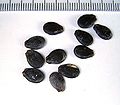This article needs additional citations for verification. (March 2013) |
Watermelon seed oil is extracted by pressing from the seeds of the Citrullus lanatus (watermelon). It is particularly common in West Africa, where it is also called ootanga oil.
The common watermelon most likely originated almost 5,000 years ago in the Kalahari Desert. Its wild ancestor, the Kalahari Melon, still grows there, and its seeds are pressed for their oil. Watermelons migrated north through Egypt, and during the Roman era they were cultivated and prized.[1]
Like their wild ancestors, modern domestic watermelon seeds can be pressed for oil. Traditionally, the seeds are extracted from the seed casing, and dried in the sun. Once dried, the seeds are pressed.
Watermelon seed oil contains high amounts of unsaturated fatty acids, primarily linoleic and oleic acids.[2]
| Fatty Acid | Percent |
|---|---|
| Palmitic acid (C16:0) | 11.0 |
| Stearic acid (C18:0) | 10.0 |
| Oleic acid (C18:1) | 15.0 |
| Linoleic acid (C18:2) | 63.0 |
| Refractive Index (40 °C) | 1.4630–1.4670 |
| Iodine value | 115–125 |
| Saponification value | 190–198 |
| Unsaponifiable matter | 1.5% max |
| Moisture | 0.5% max |
| Colour 1/2" cell (y+5R) | 20.0 units |
-
Male (top) and female (bottom) watermelon flowers in side view
-
Male watermelon flower
-
Female watermelon flower
-
Fruit
-
Seeds
See also
editReferences
edit- ^ "How to Grow Watermelon - Gardening Tips and Advice, Seeds and Plants at". Burpee.com. Retrieved 2014-04-07.
- ^ Tarek A. El-Adawy and Khaled M. Taha (2001). "Characteristics and Composition of Watermelon, Pumpkin, and Paprika Seed Oils and Flours". J. Agric. Food Chem. 49 (3): 1253–1259. doi:10.1021/jf001117+. PMID 11312845.
- ^ Solvent Extractors' Association of India Handbook (2009).
- ^ Raziq ; Grasas y Aceites. "Characterization of seed oils from different varieties of watermelon [Citrullus lanatus (Thunb.)] from Pakistan". Grasasyaceites.revistas.csic.es. Retrieved 2014-04-07.
{{cite web}}: CS1 maint: multiple names: authors list (link)




